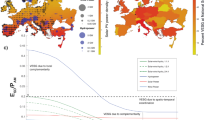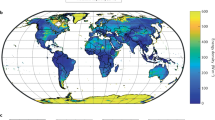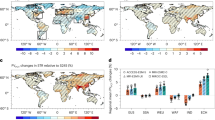Abstract
As wind and solar power provide a growing share of Europe’s electricity1, understanding and accommodating their variability on multiple timescales remains a critical problem. On weekly timescales, variability is related to long-lasting weather conditions, called weather regimes2,3,4,5, which can cause lulls with a loss of wind power across neighbouring countries6. Here we show that weather regimes provide a meteorological explanation for multi-day fluctuations in Europe’s wind power and can help guide new deployment pathways that minimize this variability. Mean generation during different regimes currently ranges from 22 GW to 44 GW and is expected to triple by 2030 with current planning strategies. However, balancing future wind capacity across regions with contrasting inter-regime behaviour—specifically deploying in the Balkans instead of the North Sea—would almost eliminate these output variations, maintain mean generation, and increase fleet-wide minimum output. Solar photovoltaics could balance low-wind regimes locally, but only by expanding current capacity tenfold. New deployment strategies based on an understanding of continent-scale wind patterns and pan-European collaboration could enable a high share of wind energy whilst minimizing the negative impacts of output variability.
This is a preview of subscription content, access via your institution
Access options
Access Nature and 54 other Nature Portfolio journals
Get Nature+, our best-value online-access subscription
$29.99 / 30 days
cancel any time
Subscribe to this journal
Receive 12 print issues and online access
$209.00 per year
only $17.42 per issue
Buy this article
- Purchase on Springer Link
- Instant access to full article PDF
Prices may be subject to local taxes which are calculated during checkout





Similar content being viewed by others
References
International Energy Agency (IEA) World Energy Outlook 2016 (Organisation for Economic Co-operation and Development, 2016).
Wallace, J. M. & Gutzler, D. S. Teleconnections in the geopotential height field during the northern hemisphere winter. Mon. Weath. Rev. 109, 784–812 (1981).
Vautard, R. Multiple weather regimes over the North Atlantic: analysis of precursors and successors. Mon. Weath. Rev. 118, 2056–2081 (1990).
Cassou, C. Intraseasonal interaction between the Madden–Julian Oscillation and the North Atlantic Oscillation. Nature 455, 523–527 (2008).
Ferranti, L., Corti, S. & Janousek, M. Flow-dependent verification of the ECMWF ensemble over the Euro-Atlantic sector. Q. J. R. Meteorol. Soc. 141, 916–924 (2015).
Cannon, D. J., Brayshaw, D. J., Methven, J., Coker, P. J. & Lenaghan, D. Using reanalysis data to quantify extreme wind power generation statistics: a 33 year case study in Great Britain. Renew. Energy 75, 767–778 (2015).
Peters, G. P. et al. Key indicators to track current progress and future ambition of the Paris Agreement. Nat. Clim. Change 7, 118–122 (2017).
Kempton, W., Pimenta, F. M., Veron, D. E. & Colle, B. A. Electric power from offshore wind via synoptic-scale interconnection. Proc. Natl Acad. Sci. USA 107, 7240–7245 (2010).
Delucchi, M. A. & Jacobson, M. Z. Providing all global energy with wind, water, and solar power, Part II: reliability, system and transmission costs, and policies. Energy Policy 39, 1170–1190 (2011).
Pfenninger, S. et al. Potential for concentrating solar power to provide baseload and dispatchable power. Nat. Clim. Change 4, 689–692 (2014).
Rodríguez, R. A., Becker, S., Andresen, G. B., Heide, D. & Greiner, M. Transmission needs across a fully renewable European power system. Renew. Energy 63, 467–476 (2014).
Pozo-Vázquez, D., Tovar-Pescador, J., Gámiz-Fortis, S. R., Esteban-Parra, M. J. & Castro-Díez, Y. NAO and solar radiation variability in the European North Atlantic region. Geophys. Res. Lett. 31, L05201 (2004).
Heide, D. et al. Seasonal optimal mix of wind and solar power in a future, highly renewable Europe. Renew. Energy 35, 2483–2489 (2010).
Santos-Alamillos, F. J., Pozo-Vázquez, D., Ruiz-Arias, J. A., Von Bremen, L. & Tovar-Pescador, J. Combining wind farms with concentrating solar plants to provide stable renewable power. Renew. Energy 76, 539–550 (2015).
Pfenninger, S. & Keirstead, J. Renewables, nuclear, or fossil fuels? Scenarios for Great Britain’s power system considering costs, emissions and energy security. Appl. Energy 152, 83–93 (2015).
Olauson, J. et al. Net load variability in Nordic countries with a highly or fully renewable power system. Nat. Energy 1, 16175 (2016).
Brayshaw, D. J., Troccoli, A., Fordham, R. & Methven, J. The impact of large scale atmospheric circulation patterns on wind power generation and its potential predictability: a case study over the UK. Renew. Energy 36, 2087–2096 (2011).
Clark, R. T., Bett, P. E., Thornton, H. E. & Scaife, A. A. Skilful seasonal predictions for the European energy industry. Environ. Res. Lett. 12, 024002 (2017).
Jerez, S. & Trigo, R. M. Time-scale and extent at which large-scale circulation modes determine the wind and solar potential in the Iberian Peninsula. Environ. Res. Lett. 8, 044035 (2013).
Santos, J. A., Belo-Pereira, M., Fraga, H. & Pinto, J. G. Understanding climate change projections for precipitation over western Europe with a weather typing approach. J. Geophys. Res. 121, 2015JD024399 (2016).
Zubiate, L., McDermott, F., Sweeney, C. & O’Malley, M. Spatial variability in winter NAO–wind speed relationships in western Europe linked to concomitant states of the East Atlantic and Scandinavian patterns. Q. J. R. Meteorol. Soc. 143, 552–562 (2017).
Pfenninger, S. & Staffell, I. Long-term patterns of European PV output using 30 years of validated hourly reanalysis and satellite data. Energy 114, 1251–1265 (2016).
Staffell, I. & Pfenninger, S. Using bias-corrected reanalysis to simulate current and future wind power output. Energy 114, 1224–1239 (2016).
Psiloglou, B. E., Giannakopoulos, C., Majithia, S. & Petrakis, M. Factors affecting electricity demand in Athens, Greece and London, UK: a comparative assessment. Energy 34, 1855–1863 (2009).
Jacobson, M. Z., Delucchi, M. A., Cameron, M. A. & Frew, B. A. Low-cost solution to the grid reliability problem with 100% penetration of intermittent wind, water, and solar for all purposes. Proc. Natl Acad. Sci. USA 112, 15060–15065 (2015).
Rodriguez, R. A., Becker, S. & Greiner, M. Cost-optimal design of a simplified, highly renewable pan-European electricity system. Energy 83, 658–668 (2015).
Diffenbaugh, N. S. & Giorgi, F. Climate change hotspots in the CMIP5 global climate model ensemble. Climatic Change 114, 813–822 (2012).
Zappa, G., Hawcroft, M. K., Shaffrey, L., Black, E. & Brayshaw, D. J. Extratropical cyclones and the projected decline of winter Mediterranean precipitation in the CMIP5 models. Clim. Dynam. 45, 1727–1738 (2015).
Tobin, I. et al. Assessing climate change impacts on European wind energy from ENSEMBLES high-resolution climate projections. Climatic Change 128, 99–112 (2015).
Hdidouan, D. & Staffell, I. The impact of climate change on the levelised cost of wind energy. Renew. Energy 101, 575–592 (2017).
UCAR/NCAR/CISL/VETS, The NCAR Command Language (v.6.2.1). UCAR/NACAR/Computational Information Systems Laboratory/Visualization and Enabling Technologies Section (2014); http://dx.doi.org/10.5065/D6WD3XH5
Michelangeli, P.-A., Vautard, R. & Legras, B. Weather regimes: recurrence and quasi stationarity. J. Atmos. Sci. 52, 1237–1256 (1995).
Dee, D. P. et al. The ERA-Interim reanalysis: configuration and performance of the data assimilation system. Q. J. R. Meteorol. Soc. 137, 553–597 (2011).
Michel, C. & Rivière, G. The link between Rossby wave breakings and weather regime transitions. J. Atmos. Sci. 68, 1730–1748 (2011).
Barnston, A. G. & Livezey, R. E. Classification, seasonality and persistence of low-frequency atmospheric circulation patterns. Mon. Weath. Rev. 115, 1083–1126 (1987).
Molod, A., Takacs, L., Suarez, M. & Bacmeister, J. Development of the GEOS-5 atmospheric general circulation model: evolution from MERRA to MERRA2. Geosci. Model Dev. 8, 1339–1356 (2015).
Heide, D., Greiner, M., von Bremen, L. & Hoffmann, C. Reduced storage and balancing needs in a fully renewable European power system with excess wind and solar power generation. Renew. Energy 36, 2515–2523 (2011).
Ely, C. R., Brayshaw, D. J., Methven, J., Cox, J. & Pearce, O. Implications of the North Atlantic Oscillation for a UK–Norway renewable power system. Energy Policy 62, 1420–1427 (2013).
Staffell, I. & Green, R. How does wind farm performance decline with age? Renew. Energy 66, 775–786 (2014).
All Photovoltaic Barometers EurObserv’ER (EurObserv’ER, 2015); http://www.eurobserv-er.org/category/all-photovoltaic-barometers
BP statistical review of world energy June 2015 (BP, 2015); http://www.bp.com/content/dam/bp/pdf/energy-economics/statistical-review-2015/bp-statistical-review-of-world-energy-2015-full-report.pdf
Global Energy CO2 Data (Enerdata, 2016); http://www.enerdata.net/enerdatauk/knowledge/subscriptions/database/energy-market-data-and-co2-emissions-data.php
Boßmann, T. & Staffell, I. The shape of future electricity demand: exploring load curves in 2050s Germany and Britain. Energy 90, 1317–1333 (2015).
Acknowledgements
C.M.G. acknowledges funding from the Swiss National Science Foundation (SNSF) via grant PZ00P2_148177/1, R.B. from AXPO Trading AG, S.P. from the European Research Council via grant StG 2012-313553, and I.S. from the Engineering and Physical Sciences Research Council via grant EP/N005996/1. Data analysis and visualization were performed using the NCAR Command Language31.
Author information
Authors and Affiliations
Contributions
C.M.G. led the study, provided the weather regime classification and plotted the data. C.M.G. and S.P. carried out the bulk of the writing. R.B., S.P. and I.S. processed the data. H.W. initiated the collaboration of C.M.G. and R.B. and early links with the ETH Climate Policy Group. All authors contributed equally to editing and discussing the manuscript.
Corresponding authors
Ethics declarations
Competing interests
The authors declare no competing financial interests.
Supplementary information
Supplementary Information
Supplementary Information (PDF 6013 kb)
Supplementary Information
Supplementary Information (ZIP 22 kb)
Rights and permissions
About this article
Cite this article
Grams, C., Beerli, R., Pfenninger, S. et al. Balancing Europe’s wind-power output through spatial deployment informed by weather regimes. Nature Clim Change 7, 557–562 (2017). https://doi.org/10.1038/nclimate3338
Received:
Accepted:
Published:
Issue Date:
DOI: https://doi.org/10.1038/nclimate3338
This article is cited by
-
Identification of weather patterns and transitions likely to cause power outages in the United Kingdom
Communications Earth & Environment (2024)
-
A climatology of weather-driven anomalies in European photovoltaic and wind power production
Communications Earth & Environment (2024)
-
Identification of reliable locations for wind power generation through a global analysis of wind droughts
Communications Earth & Environment (2024)
-
Drivers of marine heatwaves in a stratified marginal sea
Climate Dynamics (2024)
-
Balancing cleaner energy and geopolitical interests in the complex transition of the European electricity mix: from Fukushima to the Ukraine war
Discover Energy (2024)



